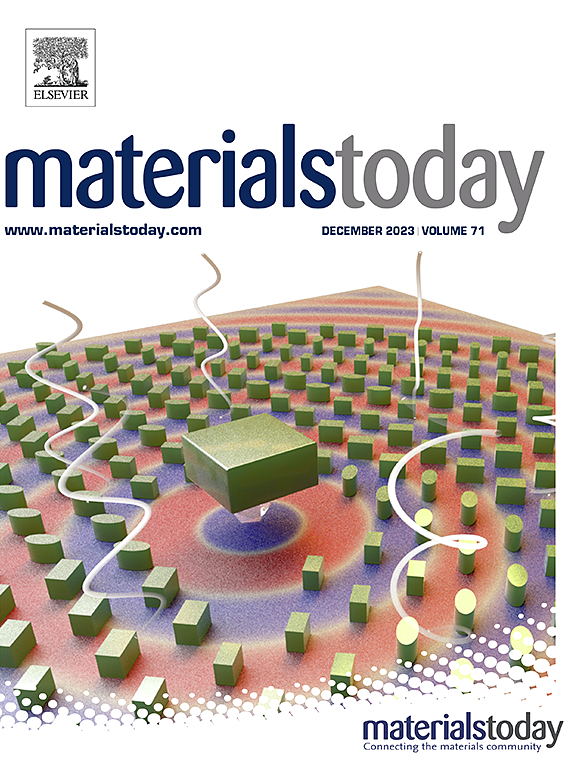Additive manufacturing of personalized, semipermeable and biodegradable polymer/metal composite membrane for guided bone regeneration
IF 21.1
1区 材料科学
Q1 MATERIALS SCIENCE, MULTIDISCIPLINARY
引用次数: 0
Abstract
The development of personalized, semipermeable, and biodegradable polymer/metal composite membranes for guided bone regeneration surgery presents a promising solution to address large and complex alveolar bone defects without the need for a secondary surgical removal. However, fabricating such membranes with a customized curved surface shape and semipermeablity remains challenging. In this study, we propose a novel methodology that integrates electrophoretic assembly (electrophoretic deposition) and laser powder bed fusion additive manufacturing processes to create personalized, semipermeable, and biodegradable polymer/metal composite membranes suitable for guided bone regeneration applications. Specifically, we first designed a personalized porous Zn substrate using an adaptively unit-cell arrayed filling method, which achieved a complex and manufacturable curved surface shape while ensuring integrity of unit cells and uniform stress distribution. Subsequently, the Zn substrate was fabricated by laser powder bed fusion, and was utilized as both the bracing structure and the template for conformal electro-growth of chitosan/gelatin cryogel to obtain the desired polymer/metal composite membrane. This composite membrane allowed efficient nutrient transfer while inhibiting 100 % fibroblasts infiltration. As compared to Zn substate, coverage of conformal chitosan/gelatin cryogel enhanced mechanical properties and reduced the biodegradation rate of the membrane. Furthermore, the composite membrane exhibited remarkable osteogenesis and anti-infection capacity in vitro. These findings highlight the promising potential of our integrated additive manufacturing approach in fabricating personalized polymer/metal composite materials for biomedical applications.

用于引导骨再生的个性化、半透性和可生物降解聚合物/金属复合膜的增材制造
用于骨再生手术的个性化、半透性和可生物降解聚合物/金属复合膜的发展为解决大而复杂的牙槽骨缺损提供了一个有希望的解决方案,而无需二次手术切除。然而,制造这种具有定制曲面形状和半透性的膜仍然具有挑战性。在这项研究中,我们提出了一种结合电泳组装(电泳沉积)和激光粉末床融合增材制造工艺的新方法,以创建适合引导骨再生应用的个性化、半透性和可生物降解的聚合物/金属复合膜。具体而言,我们首先采用自适应单元阵列填充方法设计了个性化的多孔Zn衬底,在保证单元的完整性和均匀应力分布的同时,实现了复杂和可制造的曲面形状。随后,采用激光粉末床熔融法制备Zn衬底,并将其作为支撑结构和模板用于壳聚糖/明胶低温凝胶的保形电生长,得到所需的聚合物/金属复合膜。这种复合膜允许有效的营养转移,同时抑制100%成纤维细胞的浸润。与锌基相比,保形壳聚糖/明胶低温凝胶的覆盖提高了膜的力学性能,降低了膜的生物降解率。复合膜具有良好的体外成骨和抗感染能力。这些发现突出了我们的集成增材制造方法在制造用于生物医学应用的个性化聚合物/金属复合材料方面的巨大潜力。
本文章由计算机程序翻译,如有差异,请以英文原文为准。
求助全文
约1分钟内获得全文
求助全文
来源期刊

Materials Today
工程技术-材料科学:综合
CiteScore
36.30
自引率
1.20%
发文量
237
审稿时长
23 days
期刊介绍:
Materials Today is the leading journal in the Materials Today family, focusing on the latest and most impactful work in the materials science community. With a reputation for excellence in news and reviews, the journal has now expanded its coverage to include original research and aims to be at the forefront of the field.
We welcome comprehensive articles, short communications, and review articles from established leaders in the rapidly evolving fields of materials science and related disciplines. We strive to provide authors with rigorous peer review, fast publication, and maximum exposure for their work. While we only accept the most significant manuscripts, our speedy evaluation process ensures that there are no unnecessary publication delays.
 求助内容:
求助内容: 应助结果提醒方式:
应助结果提醒方式:


